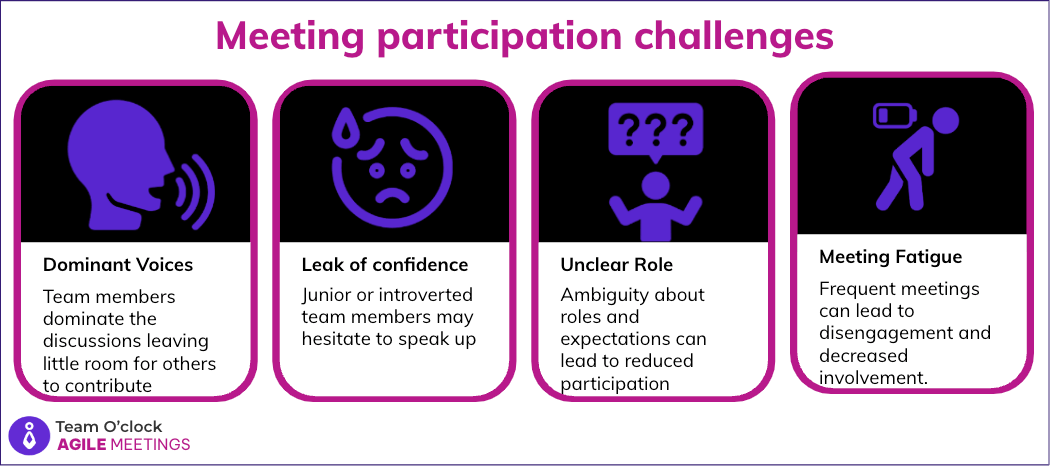
How to Achieve More Participation in an Agile Meeting

Agile methodology has introduced a modernized project management style by fostering collaboration, flexibility, and continuous improvement. However, one challenge that often arises is ensuring active participation from all team members during agile meetings.
Active engagement is crucial for the success of agile practices. Why? Because it leads to better decision-making, problem-solving, and team cohesion. This blog will show strategies to enhance participation in agile meetings, ensuring every voice is heard and valued.
Understanding the Importance of Participation in an Agile Meeting
Why Participation Matters
Active participation from all team members in an agile meeting is vital for several reasons, which are depicted in the following table:
Diverse Perspectives | Enhanced Collaboration | Early Issue Detection | Shared Ownership |
Encouraging input from all team members brings diverse viewpoints and ideas, leading to more innovative solutions. | When everyone participates, it strengthens team collaboration and trust. | Active engagement helps in identifying issues early, allowing for prompt resolution without jeopardizing the timely delivery of the project. | Participation fosters a sense of ownership and accountability among team members, leading to better project outcomes. |
What Are the Most Common Participation Challenges?
Despite the benefits, several challenges can hinder participation, such as the following:
Dominant voices: some team members dominate the discussions leaving little room for others to contribute.
Leak of confidence: Junior or introverted team members may hesitate to speak up
Unclear role: ambiguity about roles and expectations can lead to reduced participation
Meeting fatigue: frequent meetings can lead to disengagement and decreased involvement.

7 Strategies to Enhance Participation in an Agile Meeting
1. Establish a Safe and Inclusive Environment
Creating a safe and inclusive environment is foundational for encouraging participation and transparent communication.
Psychological safety: Foster an atmosphere where team members feel safe to express their ideas without fear of ridicule or retribution.
Inclusive practices: Use inclusive language and practices that welcome and prompt contributions from all team members.
Respectful communication: Encourage respectful and active listening during discussions by setting a few rules at the beginning of the meeting.
2. Define Clear Roles and Expectations
Clarity in roles and expectations helps team members understand their responsibilities and the value of their contributions.
Role clarity: Clearly define the roles and responsibilities of each team member.
Meeting objectives: Set clear objectives for each meeting so participants know what to prepare and what is expected of them before, during, and after a meeting.
3. Facilitate Balanced Discussions
Ensure that meetings are structured in a way that allows for balanced participation.
Round-robin technique: Use the round-robin technique to allow each team member to speak.
Time-boxing: Allocate specific time slots for each agenda item to prevent dominant voices from taking over.
Active facilitation: The meeting facilitator should actively manage the discussion, ensuring that quieter members have the chance to contribute.
4. Use Interactive Tools and Techniques
Interactive tools and techniques can make meetings more engaging and encourage participation.
Digital collaboration tools: Use tools like Miro, Trello, or Microsoft Teams to facilitate real-time collaboration and input.
Brainstorming sessions: Conduct brainstorming sessions using techniques like mind mapping or the 6-3-5 method.
Polls and surveys: Use polls and surveys to gather input from all team members, especially those who may be less vocal.
5. Provide Training and Support
Training and support can empower team members to participate more effectively.
Agile training: Provide training on agile principles and practices to enhance understanding and confidence.
Communication skills: Offer training on effective communication and active listening skills.
Mentoring and coaching: Implement mentoring and coaching programs to support team members' professional growth and participation.
6. Encourage Preparation and Accountability
Preparation and accountability are critical to productive meetings and active participation.
Pre-meeting agendas: Distribute agendas before meetings so participants can prepare their thoughts and contributions.
Action items and follow-up: Assign action items and follow up on them to ensure accountability and engagement.
7. Foster a Culture of Continuous Improvement
A culture of continuous improvement encourages ongoing participation and engagement among agile teams.
Retrospectives: Conduct regular retrospectives to reflect on what went well and what can be improved in meetings.
Feedback loops: Create feedback loops to gather input from team members on meeting effectiveness and participation.
Recognition and rewards: Recognize and reward active participation and valuable contributions.
Conclusion
Achieving more participation from all members in an agile meeting is essential for leveraging the full potential of agile practices. By following the above-mentioned practices such as creating a safe and inclusive environment, and defining clear roles and expectations, you can enhance participation and drive better project outcomes. Implementing these strategies successfully requires commitment and effort but ultimately leads to a more collaborative, innovative, and thriving agile team.
By prioritizing participation, organizations can ensure that every team member's voice is heard and valued and contributes to the collective success of the project.








